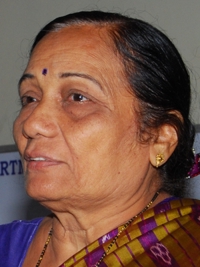Mehta, Dr. Geeta[1]
Aparigraha helps society in the removal of poverty, exploitation and slavery. It sustains and strengthens the society and keeps it peaceful. It is the milestone for a happy society and the missile for world Peace. An Aparigrahi serves the society indirectly. An Aparigrahi thinks of the needs of others and thus develops ātmaupamyata (identity with others) which leads to liberation.
The modern example of that is Mahatma Gandhi. When Gandhi was offered a shirt by an English child during his visit to England for Round Table conference, he said, 'Give me millions of shirts to mitigate the poverty of all my brethren. Thus one develops social consciousness which could pave the way to perfection.
One develops the tendency of (ātmavat sarvabhūteṣu). His inclination is not towards live and let live, but live in such a manner so that others can survive, i.e. live for others. It makes one aware of duties rather than rights. If everyone practices aparigraha, how pure and peaceful our world would be! In the contemporary context of globalization, the applied theory of aparigraha can work as a good interventionist and ecological measure to retain the balance between man and nature. The far sighted Gandhi realized its value both in strategic and spiritual terms. Gandhi writes, "If we follow the vow of aparigraha there will be real everlasting peace, because it will be peace through justice and not superficial peace. This will be the foundation of universal brotherhood".
The principle of live and let live also falls short of his stature. The only test of the fitness of man to survive is, therefore, in his letting others live or cause the unfit to survive. The peaceful co-existence of which there is so much talk in the political circles all over the world would become meaningless if it is based only on the principle of live and let live. Live and let live is the negative aspect of co-existence.
The real, the positive and peaceful co-existence has to be on the pattern of the co-existence of a mother and her newly born child lying in the same bed. Just imagine what would happen to the child and also to the mother ultimately if they decide to co-exist simply on the principle of "live and let live." When the child cries, in spite of all her personal ailments and discomforts the mother pats and feeds the child. She does not say, "Well! my child, you live where you are and let me live where I am." The mother and the child co-exist only because the mother takes over the responsibility to make otherwise 'unfit' child to survive. The peaceful co-existence between man and man and also between nation and nation is possible only on the principle of "making the unfit to survive."17
There can't be peace and happiness in society without feelings of welfare and economic equality among the nations. Today 47% of the world population gets only 5 % of resources of the world. If there is no change in this condition, there will be stress and conflict among the people.
Truly non-possessive people can adjust to any circumstances. They surrenders all their possessions to the society and society also surrenders all its possession to them - hence he becomes the richest.
Thus, if we show some awareness we can preserve the energy of our body and mind from remembering the accumulations of things, society by sharing things and cosmos by preserving the nature. If aparigraha is practiced with awareness then all, the whole world be happy and healthy.
References- Tattvartha Sutra.
- Sarvadarshana Sangraha, Sayana Madhava, Poona: Bhandarkar Oriental Research Institute,1951.
- Sarvadarshana Sangraha, translated by Cowell E.B. and Gough A.E. Delhi: Motilalal Banarasidas Publication.
- Ashram Digdarshan, Bhave Vinoba, Varanasi: Sarva Seva Sangh Prakashan, April 1964, pp.43-44.
- Prashanavyakaran Sutra, 5.1.
- Yogasūtras of Patañjali, Prin. M.R. Desai, Kolhapur: Prin. Desai Publication,1972.
- Dharati ni Aarati, Swami Anand, Bhavnagar: Lokmilap Trust, 1981
- Young India 30.4. 1925.
- Mind of Mahatma Gandhi, Complied and edited by R.K. Prabhu and U.R. Rao, Ahmedabad: Navjivan Publishing House June, 1969.
- Complete works of Mahatma Gandhi, vol. XXXI, Delhi: Govt. of Indian Publication Jan. Nov. 1926.
- Couplets from Kabir, edited., translated and completed by G.N. Das, Delhi: Motilal Banarasti Das Publication, 2002.
- Triveni, Vinoba Bhave, Varansi: Sarva Seva Prakashan.
- Gandhi Model of Development of World Peace, Editor, R.P. Mishra, an Article on Gandhian Approach to disarmament and Peace by Om Prakash Gupta, New Delhi: Concept pub. co. 1989.
- Kranti Ki Oar, Deshpande Kusum, Varanasi, Sarva Seva Prakashan, May. 1956.
- Bhoodan, Eng. Weekly,1956-1965, 10.10. 1956.
- The Harijan an English Weekly, 1948-1946,10.10.1953,256.
- Mind of Mahtma Gandhi in: Complete Works of Mahatma Gandhi, vol. XXX Feb. 1926.
 Dr. Geeta Mehta
Dr. Geeta Mehta
 Dr. Rudi Jansma
Dr. Rudi Jansma
